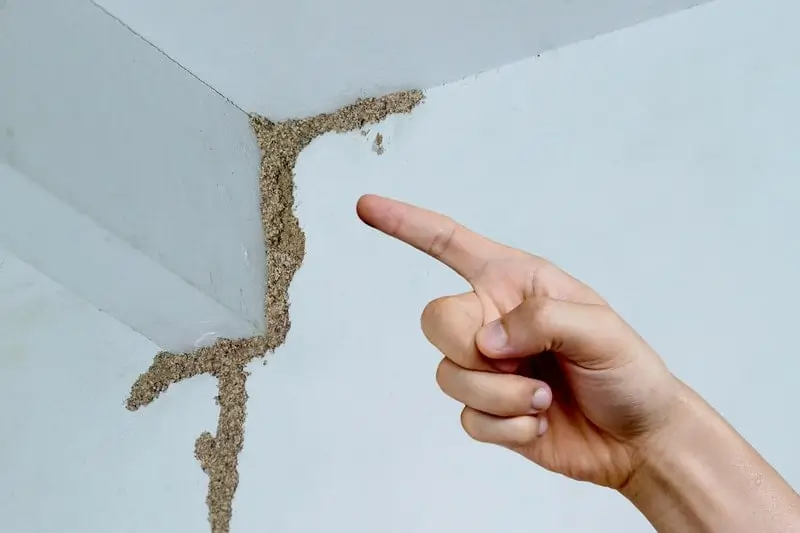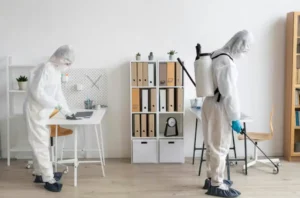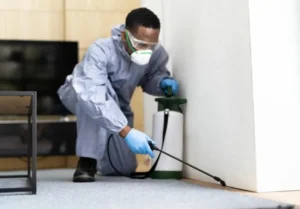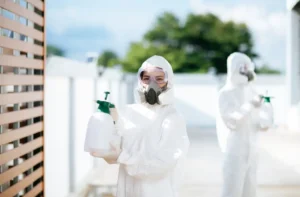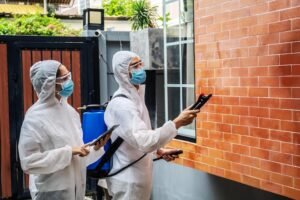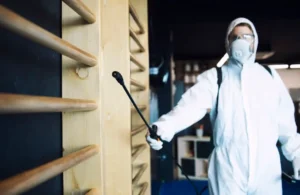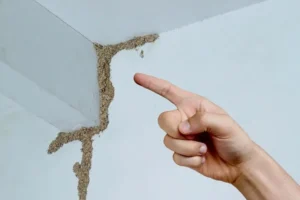Recognizing early signs of termite activity can save Norfolk homeowners thousands of dollars in repair costs. These destructive insects often work silently for months or years before their presence becomes obvious. Learning to identify subtle indicators of termite activity helps property owners seek professional help before damage becomes extensive and expensive to repair.
Mud Tubes & Shelter Tunnels
Subterranean termites build distinctive mud tubes to protect themselves while traveling between their underground colonies and food sources in structures. These pencil-thick tunnels typically appear along foundation walls, pier supports, and other areas where termites gain access to wood components. The tubes consist of soil, wood particles, and termite saliva formed into protective corridors.
Fresh mud tubes appear moist and dark, while older tubes may crack and appear lighter in color. Breaking open a tube and finding it rebuilt within a few days indicates active termite presence. Tubes may extend several feet up foundation walls or along support beams, following the path of least resistance toward food sources.
Tube Variations & Patterns
Drop tubes hang from floor joists or other structural components, allowing termites to reach food sources below their main travel routes. These tubes may be less obvious than foundation tubes but indicate extensive termite activity within structures. Exploratory tubes branch off from main travel routes as termites search for new food sources.
Working tubes are wider and more substantial than exploratory tubes, indicating established feeding areas. These tubes often connect to areas where termites are actively consuming wood. Observing tube construction patterns helps determine the extent of termite activity and likely feeding locations.
Wood Damage Patterns
Termite-damaged wood develops characteristic hollow sounds when tapped, indicating internal consumption while exterior surfaces remain largely intact. This damage pattern differs from other wood-destroying insects that typically create visible surface damage. Termites consume wood along the grain, creating distinctive galleries within structural components.
Damaged wood may show small holes where termites have pushed out waste pellets, though subterranean termites typically keep waste materials within their galleries. Wood surfaces may appear blistered or darkened in areas where termites have been feeding below the surface. Probing suspected areas with a small tool may reveal hollow areas or soft spots.
Structural Component Damage
Floor joists and support beams show damage first because termites typically access these components directly from soil contact. Sagging floors or squeaky boards may indicate termite damage to underlying support structures. These symptoms often develop gradually and may be attributed to normal settling until damage becomes severe.
Window and door frames near soil level face high termite risk and often show early damage signs. Frames may become difficult to open or close as termite feeding weakens structural integrity. Gaps around frames may increase as damaged wood loses its ability to maintain tight seals.
Swarmers & Wing Evidence
Winged reproductive termites, called swarmers, emerge from mature colonies during spring and fall months. These insects appear similar to flying ants but have straight antennae, equal-length wings, and thick waists. Swarming events typically occur during warm, humid conditions following rain events.
Discarded wings near windows, doors, or light fixtures indicate recent swarmer activity. Termites shed their wings after landing and before searching for mates and suitable nesting locations. Large numbers of wings in specific areas suggest nearby colony activity and possible new colony establishment.
Seasonal Swarming Patterns
Norfolk’s climate supports termite swarming from March through October, with peak activity during April and May. Evening hours after warm, rainy days create ideal conditions for swarming events. Property owners may notice swarmers attracted to lights during evening hours or find evidence of their presence the following morning.
Indoor swarmer sightings often indicate colonies within or immediately adjacent to structures. These insects typically emerge near their colony locations and may enter homes through small openings. Large numbers of swarmers indoors suggest significant nearby termite activity requiring professional evaluation.
Moisture & Humidity Changes
Unexplained increases in humidity levels within homes may indicate termite activity, as colonies introduce moisture through their feeding and waste elimination activities. Areas around termite feeding sites often feel more humid than surrounding spaces. Moisture meters may detect increased readings in areas where termites are active.
Water stains or discoloration on walls may indicate moisture from termite activity rather than plumbing leaks. These stains typically appear in areas where termites are active and may be accompanied by other signs of infestation. Professional evaluation helps distinguish between termite-related moisture and other sources.
Ventilation & Air Quality
Musty odors in crawl spaces or basements may indicate termite activity combined with moisture problems. These odors result from termite waste products and increased humidity levels around active feeding sites. Air quality changes may be subtle initially but become more noticeable as infestations develop.
Condensation patterns may change in areas where termites are active due to altered airflow and moisture conditions. Windows in affected areas may fog more frequently, or surfaces may feel more humid than usual. These changes often occur gradually and may be easy to overlook without careful observation.
Paint & Surface Changes
Bubbling or peeling paint on interior walls may indicate moisture problems from termite activity beneath the surface. Termites introduce moisture through their feeding activities and waste elimination, which can affect paint adhesion and appearance. These changes typically occur gradually and may be mistaken for normal paint aging.
Wallpaper may begin peeling or showing water stains in areas where termites are active behind walls. The moisture from termite colonies and feeding activities can affect adhesive bonds and create visible surface changes. Professional evaluation helps distinguish between termite-related changes and other moisture sources.
Surface Texture Modifications
Wood surfaces may develop small cracks or splits as termites consume material below the surface. These changes often appear as hairline cracks that run parallel to wood grain patterns. Surface damage may be subtle initially but becomes more pronounced as feeding continues over time.
Drywall surfaces may show small holes or depressions where termites have pushed through from behind. These openings are typically small and may be overlooked during casual observation. Probing these areas may reveal hollow spaces or soft spots indicating extensive damage behind the surface.
Sound & Vibration Indicators
Head-banging sounds from within walls may indicate soldier termites responding to vibrations by striking their heads against wood surfaces. These sounds are typically quiet but may be audible during nighttime hours when ambient noise levels are low. Tapping on walls near suspected activity areas may trigger these defensive responses.
Hollow sounds when tapping on wood surfaces indicate internal consumption by termite colonies. Structural components that previously sounded solid may develop hollow tones as termites consume internal material. Systematic tapping of support beams and framing members can help identify affected areas.
Structural Movement & Settling
Unusual settling sounds or creaking from structural components may indicate termite damage affecting load-bearing capacity. These sounds often increase during temperature changes or when loads are applied to affected structures. Professional evaluation helps distinguish between normal settling and damage-related movement.
Floor vibrations or sagging in localized areas may indicate termite damage to support structures. These changes typically develop gradually as termites consume increasing amounts of structural material. Early detection allows for repairs before damage affects overall structural integrity.
Debris & Waste Evidence
Termite pellets, called frass, may appear near feeding areas though subterranean termites typically keep waste materials within their galleries. Any pellet-like material near wood components should be investigated as possible termite evidence. These pellets are typically small, oval-shaped, and may vary in color based on the wood being consumed.
Wood particles or sawdust-like material near structural components may indicate termite feeding activity. This debris differs from carpenter ant waste, which typically includes larger wood fragments. The fine, powdery nature of termite debris reflects their thorough consumption of wood material.
Location Patterns
Debris typically accumulates in areas below active feeding sites where gravity causes material to fall. Crawl spaces, basements, and areas under stairs often collect termite-related debris. Regular cleaning of these areas helps identify new debris that might indicate developing termite activity.
Protected areas where debris can accumulate undisturbed provide the best evidence of ongoing termite activity. Areas behind stored materials, in utility rooms, or other seldom-disturbed locations may show clear evidence of termite presence over extended periods.
Professional Evaluation Importance
Many termite infestation signs can be subtle or easily confused with other property maintenance issues. Professional evaluation provides definitive identification of termite activity and assessment of damage extent. Licensed inspectors have training and equipment necessary to distinguish termite evidence from other causes of similar symptoms.
Early professional intervention prevents minor termite problems from developing into major structural damage requiring expensive repairs. The cost of professional inspection is a small investment compared to estimated repair costs from undetected termite activity.
Detailed Assessment Benefits
Professional inspections examine areas that homeowners typically cannot access safely or thoroughly. Crawl spaces, attics, and other areas where termite evidence may be present require specialized knowledge and equipment for proper evaluation. Professional assessment provides complete pictures of termite activity and property vulnerability.
Documentation from professional inspections supports warranty claims, insurance applications, and real estate transactions. Detailed inspection reports provide valuable records of property condition and any treatments or repairs that may be recommended based on findings.

